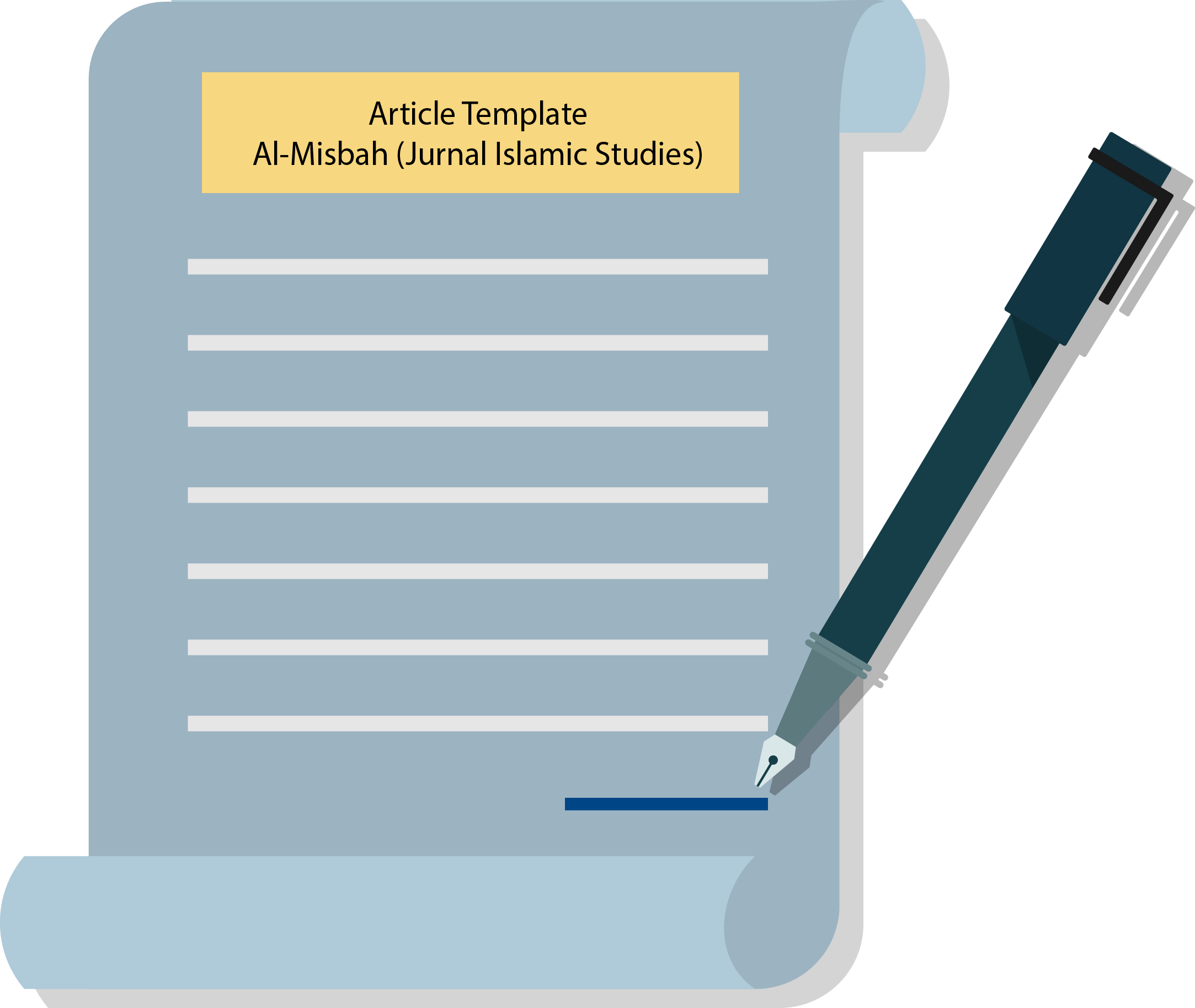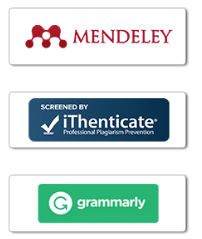The Use of Neuroscience in the Design of Arabic Learning Material Development: Its Implications for Arabic Language Education
DOI:
https://doi.org/10.26555/iwp.v1i2.4924Keywords:
Arabic, learning, materials, neuroscienceAbstract
This study aims to analyze Arabic learning materials with a neuroscience approach, to facilitate students in learning mufrodat, quwaidul arobiyah, and muhadasah. In the preliminary study, the researcher interviewed directly with the students, that so far they have found it difficult to understand, memorize, and practice mufrodat and muhadasah. Researchers provide an alternative to students at school, namely the development of Arabic language material by using neuroscience. This research data is sourced through literature observations related to scientific journal descriptions as well as scrutiny of research results references, both manually and digitally which focus on analyzing the development of Arabic learning materials by utilizing neuroscience. This type of research used is field study research with content analysis in the form of descriptive analysis. The results of the study prove that neuroscience in developing Arabic language material responds to students in accelerating memorization (mufrodat) and the practice of reading, writing, listening, and speaking (muhadasah). The development of neuroscience-based Arabic learning materials directs students with a brain approach, stimulation from the right brain and left brain as the central neuron for the growth of intelligence. The use of neuroscience in the development of Arabic language material has implications for the educational and psychological foundations of students, which are related to intelligence and affective, cognitive, and psychomotor abilities.
References
Aflisia, Noza, Nurwadjah Ahmad E.Q, and Andewi Suhartini. 2021. “The Urgency of Theological Foundations in Islamic Education in the Industry Era 4.0 towards the Society Era 5.0.†International Journal of Education Research and Development 1(1): 60–77.
Akerele, Tosin. 2021. “Embodied Conceptualisation In Yorùbá : Evidence From Spatial.†Journal of West African Language 1(2): 40–16.
Akkurt, Ibrahim Onnur. 2021. “Neurolinguistics: A Spectrum of Research Neurolinguistik: Bir Arastirma Spektrumu.†Turkish Journal of Educational Research 2(1): 24–27.
Al-Khresheh, Mohammad H., Ahmad Khaerurrozikin, and Abdul Hafidz Zaid. 2020. “The Efficiency of Using Pictures in Teaching Speaking Skills of Non-Native Arabic Beginner Students.†Universal Journal of Educational Research 8(3): 872–78.
Arifa, Laily Nur. 2021. “The Institution Of Islamic Education In The Era Of Harun Al- Rasyid.†EDUCATIO: Journal of Education 5(3): 206–16.
Aspects, Theoretical. 2020. “NegEnt : Cannabidiol-Based Aromatherapy Theoretical Aspects, Pharmacology, Clinical and Research Perspectives, Economic and Social Implications.†Internadional Journal Neuroscence Based Learning 1(June): 100–110.
Atoum, Jalal Omer, and Mais Nouman. 2019. “Sentiment Analysis of Arabic Jordanian Dialect Tweets.†International Journal of Advanced Computer Science and Applications 10(2): 256–62.
Bahril Hidayat. 2017. “Neuroscience (Neurosains) Dalam Pembelajaran Raudhatul Athfal.†Bahan Ajar (kumpulan slide materi perkuliahan )Program Studi Pendidikan Islam Anak Usia Dini Fakultas Agama Islam Universitas Islam Riau: 1. https://docplayer.info/63934450-Neuroscience-neurosains-dalam-pembelajaran-raudhatul-athfal.html.
Balogun, Adeyemi. 2021. “Religion and Prejudice: Perspectives on the Tablighi Jama’at in Ede, Southwest Nigeria.†International Journal Islamic Studies 1(2): 1–15.
Boudelaa, Sami et al. 2010. “Arabic Morphology in the Neural Language System.†Journal of Cognitive Neuroscience 22(5): 998–1010.
Betty, Mauli Rosa Bustam et al. 2021. “The Effectiveness of Fun Learning Approach in Arabic Learning.†Jurnal Al Bayan Jurusan Pendidikan Bahasa Arab 13(2): 286–304.
Desfa, Yusmaliana, Suyadi, Widodo Hendro, and Suryadin Asyraf. 2020. “Creative Imagination Base on Neuroscience : A Development and Validation of Teacher ’ s Module in Covid-19 Affected Schools.†Universal Journal of Educational Research 8(1): 5849–58.
Fauzi Muhammad Ilfan. 2020. “Pemanfaan Neurosains Dalam Desain Pengembangan Kurikulum Bahasa Arab.†Arabiyatuna : Jurnal Bahasa Arab 4(1): 1.
Hassan, Ahmed, Mahboob Ali Dehraj, and Dr. Nasrullah Kabooro. 2021. “The Impact of Private Schools on the Islamic Thoughts of Student ’ s at District Shaheed Banzirabad.†Al-A’jaz 1(8): 17–27.
Ibrahim, Mohammad Loqman, and Azlan Shaiful Baharum. 2021. “Kerangka Pembentukan Modul Pengajaran Bahasa Al-Quran Untuk Masyarakat Awam [ The Designing Framework of Quranic Language Teaching Module for the Public ].†Journal Al-Irsyad 6(1): 482–94.
Jailani, Mohammad, Hendro Widodo, et al. 2021. “Pengembangan Materi Pembelajaran Pendidikan Agama Islam: Implikasinya Terhadap Pendidikan Islam.†Al-Idarah: Jurnal Kependidikan Islam 11(1): 143–55.
Jailani, Mohammad, and Nur kholis. 2021. “Kajian Pendekatan Hermeneutika Dalam Tafsir Al- Qur ’ an.†Journal of Qur’an and Hadits Studies 10(1): 93–120.
Jailani, Mohammad, Suyadi, and Betty Mauli Rosa Bustam. 2021a. “Edisi Khas: Pengajian Islam Dan Cabaran Pandemi COVID-19.†In Perkembangan Media Pembelajaran Bahasa Arab Berasis Neurosains: Kajian Lapangan Di Sekolah Menengah Kejuruan Di Masa Covid-19, eds. Rohana Zakaria, Safinah Ismail, Mariam Mat Daud, and Syed Mohamad Zainuddin Bichk Koyak. Malaysia: Kolej Universitas Islam Antarbangngsa Selangor (KUIS), 44–50.
Jailani, Mohammad, Suyadi, and Betty Mauli Rosa Bustam. 2021b. “The First HISPISI ’ s International Conference on Humanities , Education , Law , and Social Sciences ‘ New Findings during Pandemic in Social Science , Humanities , Education and Law .’†In Neuroscience Based Islamic Learning a Critique of the Holistic Education Crisis in Pamekasan Madura, eds. Professor James A. Banks et al. Jakarta: Universitas Negeri Jakarta, 123–34.
Jailani, Mohammad, Suyadi, and Dedi Djabedi. 2021. “Menelusuri Jejak Otak Dan ’Aql Dalam Al-Qur’an Perspektif Neurosains Dan Pendidikan Islam Di Era Pandemi COVID-19.†Tadris: Jurnal Pendidikan Islam 16(1): 1–19.
Jailani, Mohammad, and Suyadi Suyadi. 2021. “Membangun Bisnis Ekonomi Islam Perspektif Neuromarketing Di Masa Pandemic Covid-19.†Islamic Economics, Finance, and Banking Review 1(2): 1–19.
Jailani, Mohammad, Suyadi Suyadi, and Muallimah Muallimah. 2021. “Pengembangan Pembelajaran Alquran Hadis Dengan Pendekatan Akal Bertingkat Ibnu Sina Di SMK Muhammadiyah 3 Yogyakarta Berbasis Neurosains: Di Masa Pandemi Covid-19.†SALAM: Jurnal Sosial dan Budaya Syar-i 8(4): 1051–66.
Jailani, Mohammad, Suyadi, Kartika Wanojaleni, and Sufyan Tsauri. 2021. “Proceeding IConIGC: International Conference on Islamic and Global Civilization.†In Penerimaan Peserta Didik Baru Di Masa Covid-19 Perspektif Neurosains: Studi Kasus Di Smk Muhammadiyah 3 Yogyakarta, Malang: Faculty of Islamic Studies University of Islam Malang, 49–65.
Jailani, Mohammad, Wantini, Suyadi, and Betty Mauli Rosa Bustam. 2021. “Meneguhkan Pendekatan Neurolinguistik Dalam Pembelajaran : Studi Kasus Pada Pembelajaran Bahasa Arab Madrasah Aliyah.†Al-Thariqah Jurnal Pendidikan Islam 6(1): 152–67.
Khozin, Wahid, and Opik Abdurrahman Taufik. 2021. “Identifikasi Gaps Pendidikan Inklusif : Studi Evaluatif Di Madrasah Ibtidaiyah Ma ’ Arif Sidomulyo , Kebumen.†Edukasi: Jurnal Penelitian Pendidikan Agama dan Keagamaan 19(1): 40–50.
Lau, Yoke Lian, Chek Kim Loi, and Mohd Nor. 2021. “The Historical Development of The Study of Broca’s Aphasia.†Malang Neurology Journal 7(2): 125–28.
Di Luca, Samuel et al. 2006. “Finger-Digit Compatibility in Arabic Numeral Processing.†Quarterly Journal of Experimental Psychology 59(9): 1648–63.
Mohammadipur, Mohammad. 2018. “Relationships Between Language Learning Strategis, Positive Emotions, Language Learning Motivation and English Language Proficiency Among Malysian ESL Undergraguates.†University Putra Malaysia.
Mustafa, Ayu Resky. 2020. “Learning Media Applications for Toddler Midwifery Care about Android-Based Fine Motor Development in Improving Midwifery Students Skills.†International Journal of Health & Medical Sciences 3(October): 130–35.
Novossiolova, Tatyana, Malcolm Dando, and Maurizio Martellini. 2021. “Enhancing the Utility of Codes of Conduct for Chemical and Biological Security through Active Learning.†ACS Chemical Health & Safety 1(2): 120–28.
Peserta Didik. 2021a. Dokumentasi Kegiatan Pemanfaatan Neurosains Dalam Pengembangan Materi Pembelajaran Bahasa Arab. Kota Yogyakarta.
Peserta Didik. 2021b. Interview Pemanfaatan Neurosains Dalam Pengembangan Materi Pembelajaran Bahasa Arab. Kota Yogyakarta.
Rini, and Partomuan Harahap. 2021. “Designing the Holistic Evaluation in Teaching Reading.†Arabiyatuna : Jurnal Bahasa Arab 5(1): 141–60.
Ritonga, Mahyudin, Hendro Widodo, Munirah, and Talqis Nurdianto. 2021. “Arabic Language Learning Reconstruction as a Response to Strengthen Al-Islam Studies at Higher Education.†International Journal of Evaluation and Research in Education 10(1): 355–63.
Sanapiah Faisal. 1982. Metodologi Penelitian Pendidikan. 1st ed. Surabaya: Usaha Nasional.
Sugiyono. 2012. Metode Penelitian Kuantitatif Kualitatif Dan R&D. 1st ed. Bandung: Alfabeta.
Suyadi. 2019a. “Hybridization of Islamic Education and Neuroscience: Transdisciplinary Studies of ’Aql in the Quran and the Brain in Neuroscience.†Dinamika Ilmu 19(2): 237–49.
Suyadi. 2019b. “Immunology Pedagogical Psychology of Pesantren Kindergarten: Multicase Study at Pesantren Kindergarten in Yogyakarta.†Addin 13(1): 57. https://doi.org/10.21043/addin.v13i1.3510.
Suyadi. 2020. Pendidikan Islam Dan Neurosains: Menelusuri Jejak Akal Dan Otak Dalam Alquran Hingga Pengembangan Neurosains Dalam Pendidikan Islam. Pertama. ed. Lintang Novita. Jakarta: Kencana. www.Prenamedia.com.
Suyadi, Zalik Nuryana, and Niki Alma Febriana Fauzi. 2020. “The Fiqh of Disaster: The Mitigation of Covid-19 in the Perspective of Islamic Education-Neuroscience.†International Journal of Disaster Risk Reduction 51(2): 1–15. https://doi.org/10/1016/J.ijdrr.2020.101848.
Suyadi, and Sutrisno. 2018. “A Genealogycal Study of Islamic Education Science at the Faculty of Ilmu Tarbiyah Dan Keguruan UIN Sunan Kalijaga.†Al-Jami’ah 56(1): 29–58.
Suyadi, and Hendro Widodo. 2019. “Millennialization Of Islamic Education Based On Neuroscience In The Third Generation University In Yogyakarta Indonesia.†QIJIS: Qudus International Journal of Islamic Studies 7(1): 173–202.
Tripathi, Anurag. 2019. “Language & Speech Disorders – It All Starts in the Brain.†Science Reporter 4(9): 1–10.
Vogel, Stephan E., Celia Goffin, and Daniel Ansari. 2015. “Developmental Specialization of the Left Parietal Cortex for the Semantic Representation of Arabic Numerals: An FMR-Adaptation Study.†Developmental Cognitive Neuroscience 12(1): 61–73. http://dx.doi.org/10.1016/j.dcn.2014.12.001.
Wargadinata, Wildana, Iffat Maimunah, Saidna Zulfiqar Bin Tahir, and M Chairul Basrun Umanailo. 2020. “Arabic Creative and Participative Learning: In Search of a New Way of Language Learning by ‘El Jidal Reborn’ Youth Community in Malang.†International Journal of Advanced Science and Technology Vol. 2(No. 8s): 4319–32.
Zaini, Abdul Razif, Yaakob Hasan, and Muhammad Harun Husaini. 2021. “Saiz Kosa Kata Bahasa Arab Dalam Kalangan Penuntut Tahun Akhir Kolej Universiti Islam Antarabangsa Selangor ( KUIS ) [ Arabic Vocabulary Size among Kolej Universiti Islam Antarabangsa Selangor ( KUIS ) Final Year Students ].†Al-Irsyad Journal of Islamic Contemporay Issue 6(1): 606–14.
Zainuddin, Nurkhamimi, Noor Saazai Mat Saad, Haliza Harun, and Harwati Hashim. 2020. “Development of Arabic Language Lifelong Learning (A3L) Tutorial Platform Using WhatsApp Mobile Application.†Creative Education 11(04): 452–67.
Zakir, Supratman et al. 2021. “Development of 3D Animation Based Hydrocarbon Learning Media.†Journal of Physics: Conference Series 1779(1).
Downloads
Published
Issue
Section
License
Copyright (c) 2021 Mohammad Jailani

This work is licensed under a Creative Commons Attribution-ShareAlike 4.0 International License.
Authors who publish with Islam in world perspectives agree to the following terms:
- Authors retain copyright and grant the journal right of first publication with the work simultaneously licensed under a Creative Commons Attribution License (CC BY-SA 4.0) that allows others to share the work with an acknowledgment of the work's authorship and initial publication in this journal.
- Authors are able to enter into separate, additional contractual arrangements for the non-exclusive distribution of the journal's published version of the work (e.g., post it to an institutional repository or publish it in a book), with an acknowledgment of its initial publication in this journal.
- Authors are permitted and encouraged to post their work online (e.g., in institutional repositories or on their website) prior to and during the submission process, as it can lead to productive exchanges, as well as earlier and greater citation of published work.

This work is licensed under a Creative Commons Attribution-ShareAlike 4.0 International License.


